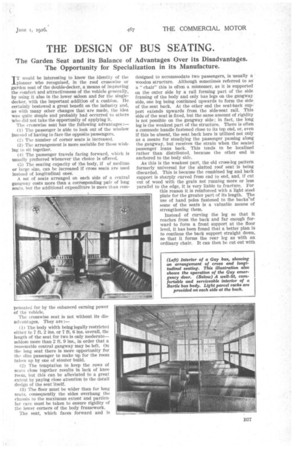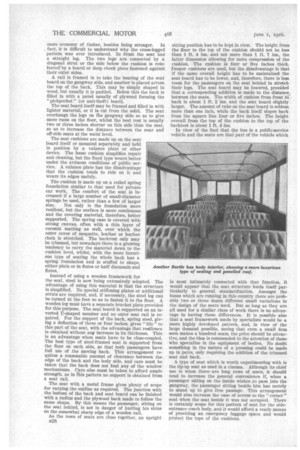THE DESIGN OF BUS SEATING.
Page 41

Page 42

If you've noticed an error in this article please click here to report it so we can fix it.
The Garden Seat and its Balance of Advantages Over its Disadvantages. The Opportunity for Specialization in its Manufacture.
IT would be interesting to know the identity of the pioneer who recognized, in the roof crosswise or garden seat of the double-decker, a means of improving the comfort and attractiveness of the vehicle generally, by using it also In the lower saloon and for the singledecker, with the important addition of a cushion. He certainly bestowed a great benefit on the industry and, as with many other changes that are made, the idea was quite simple and probably had occurred to others 7who did not take the opportunity of applying it.
The crosswise seat has the following advantages :— (1) The passenger is able to look out of the window Instead of having to face the opposite passengers.
(2) The number of corner seats is increased.
(3) The arrangement is more sociable for those wishing to sit together.
(4) The passenger travels facing forward, which is usually preferred whenever the choice is offered.
(5) The seating capacity of the body, if of medium or large size, can be increased if 'cross seats are used instead of longitudinal ones.
A set of seats arranged on each side of a central gangway costs more than a corresponding pair of long seats, but the additional expenditure is more than corn.
pensated for by the enhanced earning power of the vehicle.
The crosswise seat is not without its disadvantages. They a re :— (1) The body width being legally restricted either to 7 ft. 2 ins. or 7 ft. 6 ins, overall, the length of the seat for two is only moderate-seldom more than 2 ft. 9 ins., in order that a reasonable central gangway may be left On the long seat there is more opportunity for the slim passenger to make up for the room taken lip by one of stouter build.
(2) The temptation to keep the rows of seats close together results in lack of knee room, but this can be alleviated to a great extent by paying close attention to the detail design of the seafitself.
(3) The floor must be wider than for long seats, consequently the sides overhang the chassis to the maximum extent and particular care must be taken to ensure rigidity of the lower corners of the body framework.
The seat, which faces forward and is designed to accommodate two passengers, is usually a wooden structure. Although sometimes referred to as a "chair" this is often a misnomer, as it is supported on the outer side by a rail forming part of the side framing of the body and only has legs on the gangway side, one leg being continued upwards to form the side of the seat back. At the other end the seat-back support extends upwards from the side-seat rail. This side of the seat is fixed, but the same amount of rigidity is not possible on the gangway side; in fact, the long leg is the weakest part of the structure. There is often a commode handle fastened close to its top end, or, even if this be absent, the seat back here is utilized not only as a means for steadying the passenger passing along the gangway, but receives the strain when the seated passenger leans back. This tends to be localized rather than distributed, because the other end is anchored to the body side.
As this is the weakest part, the old crass-leg pattern formerly universal for the slatted roof seat is being discarded. This is because the combined leg and back support is sharply curved from end to end, and, if cut out of wood with the grain not running more or less parallel to the edge, it is very liable to fracture. For this reason it is reinforced with a light steel plate for the greater part of its length. The use of hand poles fastened to the backs''of some of the seats is a valuable means of strengthening them.
Instead of curving the leg so that it reaches from the back and far enough forward to form a front support at the floor level, it has been found that a better plan is to continue the back support straight down, so that it forms the rear leg as with an ordinary chair. It can then be cut out with
more economy of timber, besides being stronger. In fact, it is difficult to understand why the cross-legged pattern was ever introduced. In front the seat has a straight leg. The two legs are connected by a diagonal strut or the side below the cushion is reinforced-by a board or deep cheek piece fastened against their outer sides.
A rail is framed in to take the bearing of the seat board on the gangway side, and another is placed across the top of the back. This may be simply shaped in wood, but usually it is padded. Below this the back is filled in with a panel usually of plywood forming the " pickpocket " (or anti-theft) board.
The seat board itself may be framed and filled in with lighter material, or it is cut frotn the solid. The seat overhangs the legs on the gangway side so as to give more room on the floor, whilst the best rest is usually two or three inches shorter on this side than the seat, so as to increase the distance between the near and off-side seats at the waist leveL The seat cushions are made up on the seat board itself or mounted separately and held in position by a valance plate or other device. The loose cushion simplifies repair and cleaning, but the fixed type wears better under the arduous conditions of public service. A valance plate has the disadvantage that the cushion tends to ride on it and wears its edges unduly.
The cushion is made up on a coiled spring foundation similar to that used for private car work. The comfort of the seat is increased if a large number of small-diameter springs be used, rather than a few of larger size. Not only is the foundation more resilient, but the surface is more continuous and the covering material, therefore, better supported. The spring case is covered with strong canvas, often with a thin layer of coconut matting as well, over which the outer cover of moquette, leather or leather cloth is stretched. The backrest only may be trimmed, but nowadays there is a growing tendency to carry the material down to the cushion level, whilst, with the more luxurious type of seating the whole back has a spring foundation and is stuffed to shape, either plain or in flutes or half diamonds and flutes.
Instead of using a wooden framework for the seat, steel is now being extensively adopted. The advantage of using this material is that the structure is simplified. No special stiffening plates or additional struts are required, and, if necessary, the steel leg can be turned at the foot so as to fasten it to the floor. A wooden leg must have a separate bracket plate provided for this purpose. The seat board is supported on an inverted U-shaped member and no outer seat rail is required. For the support of the back, spring steel, giving a deflection of three or four inches, gives " life " to this part of the seat, with the advantage that resilience is obtained without any increase in its thickness. This is an advantage when seats have to be close-coupled. The best type of steel-framed seat is supported from the floor on each side, so that both passengers have full use of the moving back. This arrangement requires a reasonable amount of clearance between the edge of the back and the body side, and care must be taken that the back does not foul any of the window mechanisms. Care also must be taken to afford ample strength, as in This pattern no support is obtained from a seat rail.
The seat with a metal frame gives plenty of scope for varying the outline as required. The junction with the bottom of the back and seat board can be finished with a radius and the plywood back made to follow the same shape. By this means the passenger, sitting on the seat behind, is not in danger of hurting his shins on the somewhat sharp edge of a wooden rail. As the rows of seats are close together, an upright B28
sitting position has to be kept in view. The height from the floor to the top of the cushion sholdd not be less than 1 ft. 4 ins. and not more than 1 ft. 7 ins., the latter dimension allowing for more compression of the cushion. The cushion is four or five inches thick. Deeper cushions are used, but the disadvantage is that if the same overall height has to be maintained the seat board has to be lower, and, therefore, there is less room for the passengers on the seat behind to stretch their legs. The seat board may be lowered, provided that a corresponding addition is made to the distance between the seats. The width of cushion from front to back is about 1 ft. 2 ins, and the seat board slightly larger. The amount of rake on the seat board is seldom more than one inch, while the back itself slopes back from the square line four or five inches. The height overall from the top of the cushion to the top of the backrest is about 1 ft. 4 ins.
In view of the fact that the bus is a public-service vehicle and the seats are that part of the vehicle which is most intimately connected with that function, it would appear that the seat structure lends itself particularly to general standardization. Amongst the buses which are running in this country there are probably two or three dozen different small variations in the design of the seats used. But so long as they are all used for a similar class of work there is no advantage in having these differences. It is possible also that a seat framework made by specialists would be a more highly developed pattern, and, in view of the large demand possible, seeing that even a small firm soon makes a hundred seats, the price should be attractive, and the idea is commended to the attention of those who specialize in the equipment of bodies. No doubt something in the nature of a pressing could be made up in pairs, only requiring the addition of the trimmed seat and back.
A type of seat which is worth experimenting with is the tip-up seat as used in a cinema. Although its chief use is when there, are long rows of seats, it should tend to increase the general convenience if, when a passenger sitting on the inside wishes ,to pass into the gangway, the passenger sitting beside him has merely to stand up to give free passage. This arrangement would also increase the ease of access to the " corner " seat when the seat beside it was not occupied. There is certainly scope for this pattern of seat for the sideentrance coach body, and it would afford a ready means of providing an emergency luggage space and would protect the tops of the cushions.


























































